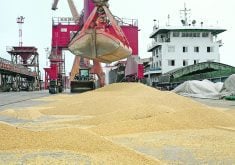The world’s only durum futures contract has stopped breathing, but may still live.
In this state of limbo, buyers and sellers can’t use it to determine the value of the grain, and the Canadian Wheat Board can’t use it to offer fixed price durum contracts, as it has done with spring wheat.
The problem is that no one is trading the contract, said Curt Denisuik, a member of the MGE’s board of directors and the Canadian Wheat Board’s director of commodity risk management.
“As the year has gone on, we haven’t really seen anyone trade the contract. It was a nice attempt. It’s too bad it didn’t work.”
Read Also

Defence investments could benefit agriculture
A bump in Canada’s NATO spending commitments could lead to infrastructure investments that would benefit rural areas
Denisuik and MGE chair Mike Miller said the contract has never been able to satisfy both sellers and buyers of durum at the same time.
“Without two parties, a buyer and a seller, it’s pretty hard to have a contract,” Denisuik said.
The contract was introduced in 1998 and had moderate use, but quickly lost popularity and had crashed by 2001. Open interest has almost completely evaporated.
The contract’s first specifications pleased U.S. processors, who needed tight specifications to guarantee that they would not be vulnerable to low-quality grain being delivered against the contract.
But farmers were scared of using the contract in case growing and harvesting conditions left them with an insufficient amount of high-quality durum to match their obligations. The contract did not lower their risk.
So the specifications were changed in 2000 to make the contract more enticing to farmers. It also made durum prices reflect international prices more closely.
That worked to get farmers interested, but alienated processors.
“The contract as it’s currently structured doesn’t provide for a realistic hedge for buyers,” said Miller, who owns a milling company.
“The quality specifications of the current contract would not allow a flour miller to take delivery under the contract and make semolina acceptable to the pasta market in the United States.
“If a flour miller sold semolina and bought futures as a hedge, you would still be exposed to risk because at the time that you went to turn that futures contract into a cash contract, the spread between the futures contract and the cash contract could be enormous. Could be a dollar a bushel.”
Denisuik said the wheat board became one of the contract’s major users and had hoped it would become reliable.
“We used it extensively once it was launched, but it was very difficult to find someone to take the other side.”
The board found the first version of the contract didn’t reflect world prices, which was a critical problem.
“It wasn’t what durum was trading at (on the world market),” Denisuik said.
Algeria makes up 40 percent of world trade demand, but it and other global buyers don’t use the contract. That meant the supply and demand revealed by the Minneapolis contract was really only the U.S. domestic market.
Miller said he believes the contract can be saved, but the quality issue has to be dealt with and it has to cover a larger area. He said there might be enough liquidity to keep it working if it included Mexico and the southwestern U.S. durum growing areas.
Miller also said durum has been a hard commodity to accommodate in the futures markets because of its brutal quality cutoff and its price stability.
Unlike wheat, which has many markets for many uses, durum is used almost exclusively in North America for making pasta. Its value collapses if quality falls below pasta specifications.
“Instead of having a gradual spread of quality, you have a cliff,” Miller said.
As well, durum prices have been static in recent years. Without volatility in the market, neither buyers nor sellers have felt the need for price protection.
Because the durum contract isn’t working, the CWB won’t be able to offer cash pricing for durum as it has with some other classes of grain, Denisuik said.
“If there was a hedge vehicle out there, we’d be able to offer similar programs for durum producers as we can for the wheat producers, because we’d have an ability to hedge our exposure,” he said. “Without that, it pretty much prevents us from doing that, and that’s unfortunate.”
It also means the board takes more risks when making contracts with buyers.















